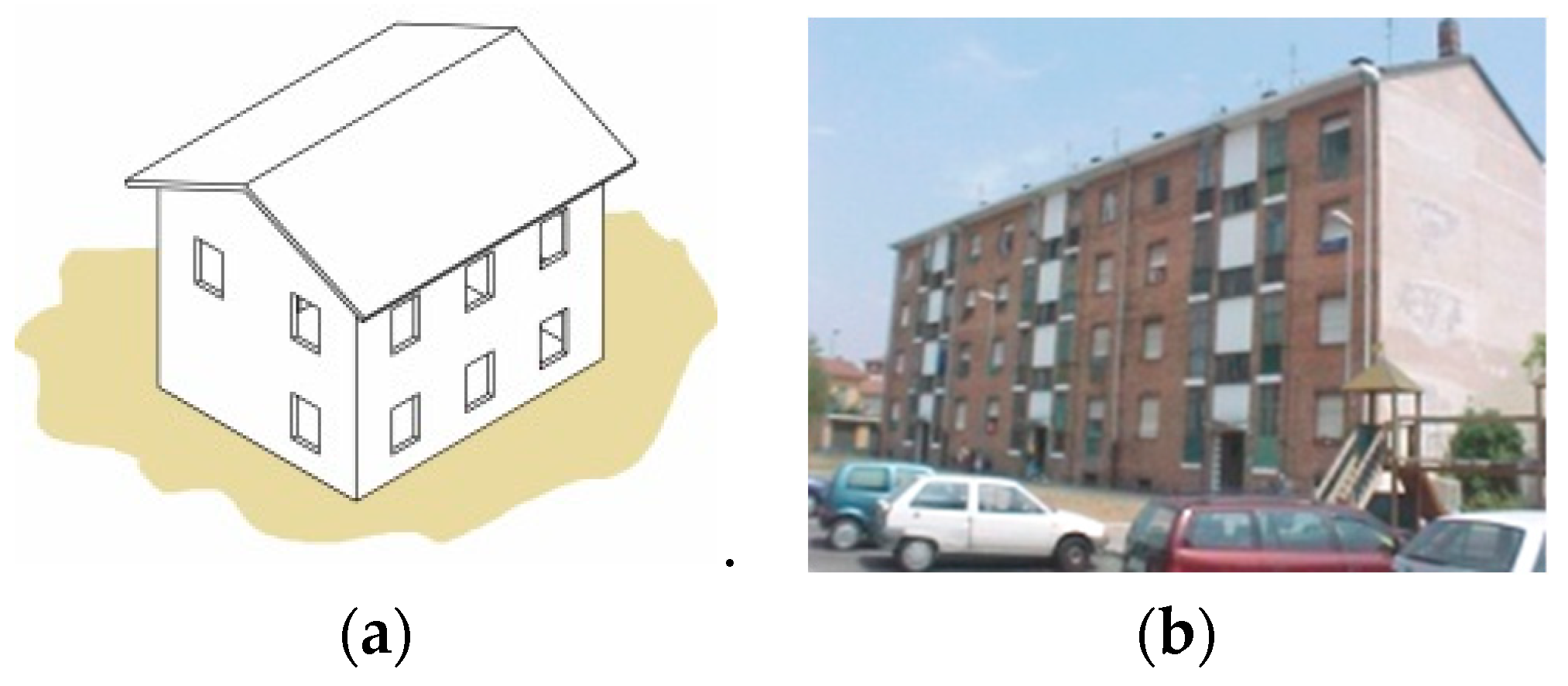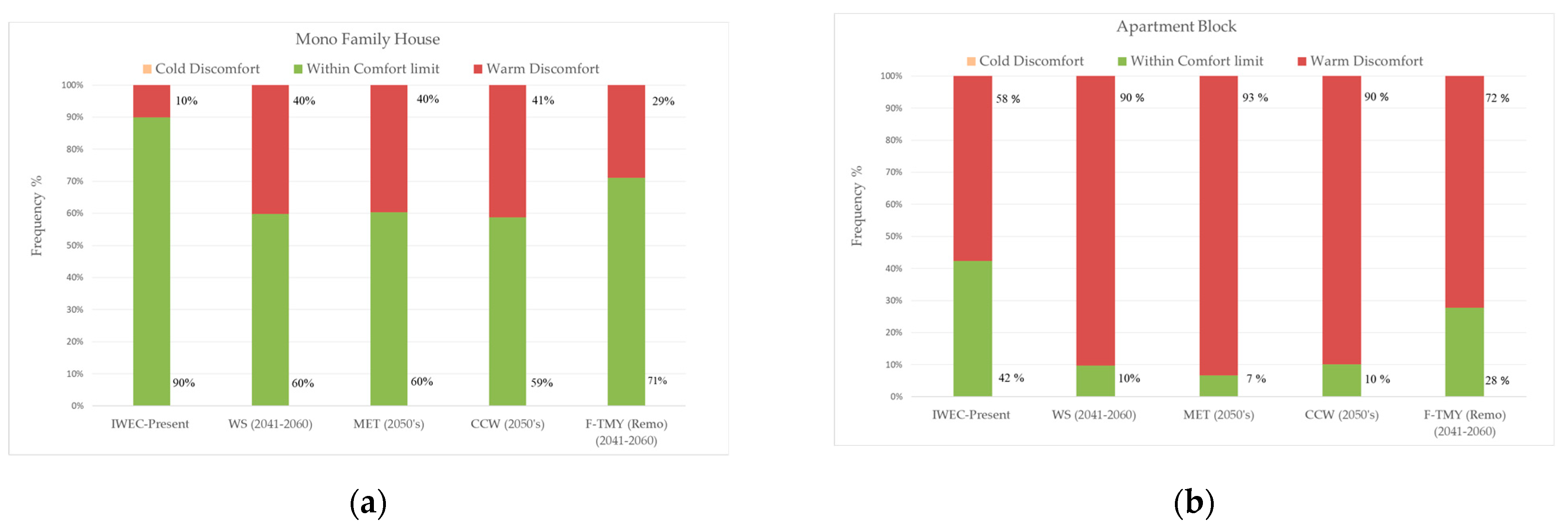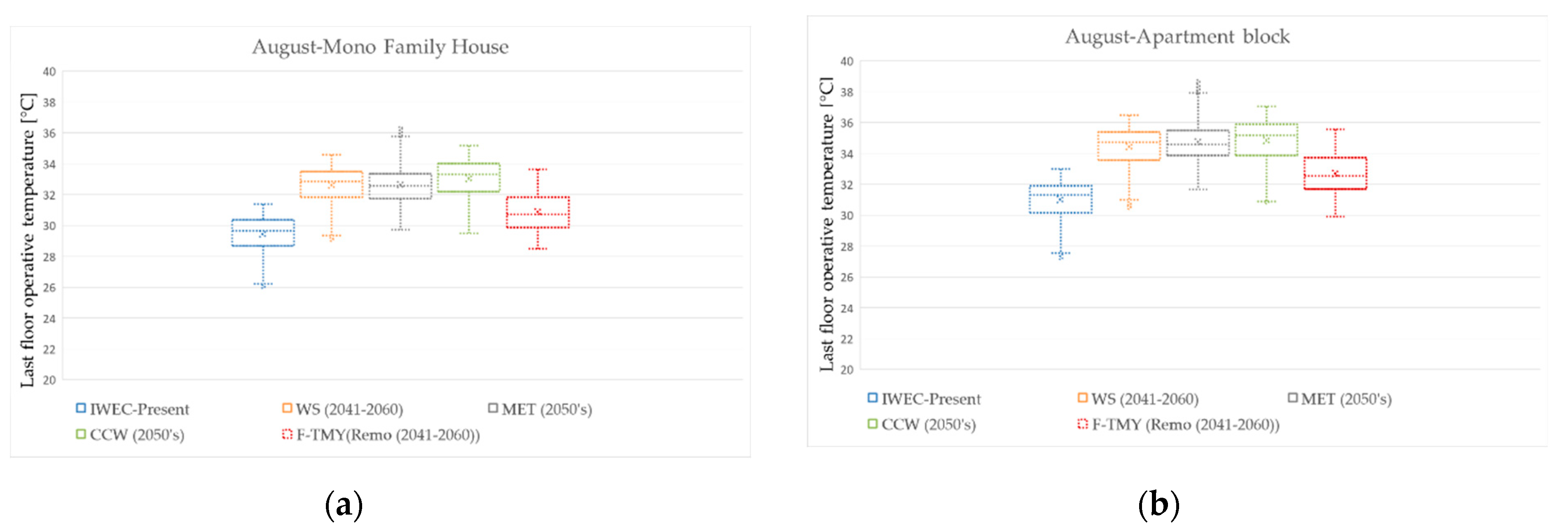A Comparative Analysis of Different Future Weather Data for Building Energy Performance Simulation
Abstract
1. Introduction
2. Review of GCMs Downscaling Methods
2.1. Statistical Downscaling
2.1.1. Stochastic Weather Generation
2.1.2. Time Series Adjustment: Morphing
- The Shift is applied when absolute monthly mean change (Δxm) derived from a GCM or RCM is predicted for a given variable (x0) such as atmospheric pressure, for the month m, according to Equation (1):xm = x0 + Δxm.
- The Stretch is applied when a relative monthly mean change (αm) derived from a GCM or RCM is predicted for a given variable (x0) such as wind speed, for the month m, according to Equation (2):xm = αm · x0.
- The combination of Shift and Stretch is applied when both absolute and relative monthly mean changes derived from a GCM or RCM are predicted for a given variable (x0) such as dry-bulb temperature, for the month m, according to Equation (3):xm = x0 + Δxm + αm (x0 − x0,m)
2.2. Dynamical Downscaling
3. Materials and Methods
3.1. Describing Future Weather Data Generation for Rome
3.1.1. Meteonorm
3.1.2. CCWorldWeatherGen
3.1.3. WeatherShift
3.1.4. TMY out of GERICS-REMO-2015
3.2. Energy Performance and Thermal Comfort Assessment
3.3. Definition of Case Studies
4. Results and Discussion
5. Conclusions
Author Contributions
Funding
Data Availability Statement
Acknowledgments
Conflicts of Interest
References
- World Meteorological Organization. WMO Report on The Global Climate in 2015-2019; World Meteorological Organization: Geneva, Switzerland, 2019. [Google Scholar]
- Symon, C. Climate change: Action, trends and implications for business. In The IPCC’s Fifth Assessment Report, Working Group 1; IPCC: Geneva, Switzerland, 2013. [Google Scholar]
- Della-Marta, P.M.; Haylock, M.R.; Luterbacher, J.; Wanner, H. Doubled length of western European summer heat waves since 1880. J. Geophys. Res. Space Phys. 2007, 112. [Google Scholar] [CrossRef]
- National Climate Services Network of Italy, ISPRA. Future Climate in Italy—An Analysis of Regional Climate Models Projections; ISPRA: Roma, Italy, 2015; ISBN 978-88-448-0723-8. [Google Scholar]
- Muthers, S.; Laschewski, G.; Matzarakis, A. The Summers 2003 and 2015 in South-West Germany: Heat Waves and Heat-Related Mortality in the Context of Climate Change. Atmosphere 2017, 8, 224. [Google Scholar] [CrossRef]
- D’Ippoliti, D.; Michelozzi, P.; Marino, C.; De’Donato, F.; Menne, B.; Katsouyanni, K.; Kirchmayer, U.; Analitis, A.; Medina-Ramón, M.; Paldy, A.; et al. The impact of heat waves on mortality in 9 European cities: Results from the EuroHEAT project. Environ. Health 2010, 9, 37. [Google Scholar] [CrossRef] [PubMed]
- Tan, J.; Zheng, Y.; Tang, X.; Guo, C.; Li, L.; Song, G.; Zhen, X.; Yuan, D.; Kalkstein, A.J.; Li, F.; et al. The urban heat island and its impact on heat waves and human health in Shanghai. Int. J. Biometeorol. 2009, 54, 75–84. [Google Scholar] [CrossRef] [PubMed]
- Salimi, M.; Al-Ghamdi, S.G. Climate change impacts on critical urban infrastructure and urban resiliency strategies for the Middle East. Sustain. Cities Soc. 2020, 54, 101948. [Google Scholar] [CrossRef]
- McEvoy, D.; Ahmed, I.; Mullett, J. The impact of the 2009 heat wave on Melbourne’s critical infrastructure. Local Environ. 2012, 17, 783–796. [Google Scholar] [CrossRef]
- Xia, Y.; Li, Y.; Guan, D.; Tinoco, D.M.; Xia, J.; Yan, Z.; Yang, J.; Liu, Q.; Huo, H. Assessment of the economic impacts of heat waves: A case study of Nanjing, China. J. Clean. Prod. 2018, 171, 811–819. [Google Scholar] [CrossRef]
- Herbel, I.; Croitoru, A.-E.; Rus, A.V.; Roşca, C.F.; Harpa, G.V.; Ciupertea, A.-F.; Rus, I. The impact of heat waves on surface urban heat island and local economy in Cluj-Napoca city, Romania. Theor. Appl. Clim. 2018, 133, 681–695. [Google Scholar] [CrossRef]
- Nakicenovic, N.; Alcamo, J.; Davis, G.; Vries, B.D.; Fenhann, J.; Gaffin, S.; Gregory, K.; Grubler, A.; Jung, T.Y.; Kram, T.; et al. Special Report on Emissions Scenarios; IPCC: Geneva, Switzerland, 2000. [Google Scholar]
- Dimoudi, A.; Tompa, C. Energy and environmental indicators related to construction of office buildings. Resour. Conserv. Recycl. 2008, 53, 86–95. [Google Scholar] [CrossRef]
- Shen, P. Impacts of climate change on U.S. building energy use by using downscaled hourly future weather data. Energy Build. 2017, 134, 61–70. [Google Scholar] [CrossRef]
- Berardi, U.; Jafarpur, P. Assessing the impact of climate change on building heating and cooling energy demand in Canada. Renew. Sustain. Energy Rev. 2020, 121, 109681. [Google Scholar] [CrossRef]
- Flores-Larsen, S.; Filippín, C.; Barea, G. Impact of climate change on energy use and bioclimatic design of residential buildings in the 21st century in Argentina. Energy Build. 2019, 184, 216–229. [Google Scholar] [CrossRef]
- Soutullo, S.; Giancola, E.; Jiménez, M.J.; Ferrer, J.A.; Sánchez, M.N. How Climate Trends Impact on the Thermal Performance of a Typical Residential Building in Madrid. Energies 2020, 13, 237. [Google Scholar] [CrossRef]
- Da Guarda, E.L.A.; Domingos, R.M.A.; Jorge, S.H.M.; Durante, L.C.; Sanches, J.C.M.; Leão, M.; Callejas, I.J.A. The influence of climate change on renewable energy systems designed to achieve zero energy buildings in the present: A case study in the Brazilian Savannah. Sustain. Cities Soc. 2020, 52, 101843. [Google Scholar] [CrossRef]
- Zhai, Z.J.; Helman, J.M. Implications of climate changes to building energy and design. Sustain. Cities Soc. 2019, 44, 511–519. [Google Scholar] [CrossRef]
- Chai, J.; Huang, P.; Sun, Y. Investigations of climate change impacts on net-zero energy building lifecycle performance in typical Chinese climate regions. Energy 2019, 185, 176–189. [Google Scholar] [CrossRef]
- Herrera, M.; Natarajan, S.; Coley, D.A.; Kershaw, T.; Ramallo-González, A.P.; Eames, M.; Fosas, D.; Wood, M. A review of current and future weather data for building simulation. Build. Serv. Eng. Res. Technol. 2017, 38, 602–627. [Google Scholar] [CrossRef]
- Hall, I.J.; Prairie, R.R.; Anderson, H.E.; Boes, E.C. Generation of a Typical Meteorological Year (No. SAND-78-1096C; CONF-780639-1); Sandia Labs: Albuquerque, NM, USA, 1978. [Google Scholar]
- Barnaby, C.S.; Crawley, D.B. Weather data for building performance simulation. In Building Performance Simulation for Design and Operation; Routledge: London, UK, 2011. [Google Scholar]
- Finkelstein, J.M.; Schafer, R.E. Improved goodness-of-fit tests. Biometrika 1971, 58, 641–645. [Google Scholar] [CrossRef]
- Jentsch, M.F.; James, P.A.; Bourikas, L.; Bahaj, A.S. Transforming existing weather data for worldwide locations to enable energy and building performance simulation under future climates. Renew. Energy 2013, 55, 514–524. [Google Scholar] [CrossRef]
- Dias, J.B.; Da Graça, G.C.; Soares, P.M. Comparison of methodologies for generation of future weather data for building thermal energy simulation. Energy Build. 2020, 206, 109556. [Google Scholar] [CrossRef]
- Moazami, A.; Nik, V.M.; Carlucci, S.; Geving, S. Impacts of future weather data typology on building energy performance—Investigating long-term patterns of climate change and extreme weather conditions. Appl. Energy 2019, 238, 696–720. [Google Scholar] [CrossRef]
- U.S. Department of Energy’s (DOE). Energy Plus Software, v. 9.0. Available online: https://energyplus.net/ (accessed on 2 September 2020).
- Köppen, W. Die Wärmezonen der Erde, nach der Dauer der heissen, gemässigten und kalten Zeit und nach der Wirkung der Wärme auf die organische Welt betrachtet. Meteoro. Z. 1884, 1, 5–226. [Google Scholar]
- Hawkins, E.; Sutton, R.T. The Potential to Narrow Uncertainty in Regional Climate Predictions. Bull. Am. Meteorol. Soc. 2009, 90, 1095–1108. [Google Scholar] [CrossRef]
- Hawkins, E.; Sutton, R. The potential to narrow uncertainty in projections of regional precipitation change. Clim. Dyn. 2011, 37, 407–418. [Google Scholar] [CrossRef]
- Ramon, D.; Allacker, K.; Van Lipzig, N.P.M.; De Troyer, F.; Wouters, H. Future Weather Data for Dynamic Building Energy Simulations: Overview of Available Data and Presentation of Newly Derived Data for Belgium. Energy Environ. Sustain. 2018, 111–138. [Google Scholar] [CrossRef]
- Uppala, S.M.; Kållberg, P.W.; Simmons, A.J.; Andrae, U.; Bechtold, V.D.C.; Fiorino, M.; Gibson, J.K.; Haseler, J.; Hernandez, A.; Kelly, G.A.; et al. The ERA-40 re-analysis. Q. J. R. Meteorol. Soc. 2005, 131, 2961–3012. [Google Scholar] [CrossRef]
- Laflamme, E.M.; Linder, E.; Pan, Y. Statistical downscaling of regional climate model output to achieve projections of pre-cipitation extremes. Weather. Clim. Extrem. 2016, 12, 15–23. [Google Scholar] [CrossRef]
- Belcher, S.; Hacker, J.; Powell, D. Constructing design weather data for future climates. Build. Serv. Eng. Res. Technol. 2005, 26, 49–61. [Google Scholar] [CrossRef]
- American Meteorological Society. Regional climate model. In Glossary of Meteorology; American Meteorological Society: Boston, MA, USA, 2013. [Google Scholar]
- Soares, P.M.; Cardoso, R.M.; Miranda, P.M.; de Medeiros, J.; Belo-Pereira, M.; Espirito-Santo, F. WRF high resolution dynam-ical downscaling of ERA-Interim for Portugal. Clim. Dyn. 2012, 39, 2497–2522. [Google Scholar] [CrossRef]
- Van der Linden, P.; Mitchell, J.E. ENSEMBLES: Climate Change and its Impacts: Summary of Research and Results from the ENSEMBLES Project; Met Office Hadley Centre: Exeter, UK, 2009. [Google Scholar]
- Jacob, D.; Petersen, J.; Eggert, B.; Alias, A.; Christensen, O.B.; Bouwer, L.M.; Braun, A.; Colette, A.; Déqué, M.; Georgievski, G.; et al. EURO-CORDEX: New high-resolution climate change projections for European impact research. Reg. Environ. Chang. 2014, 14, 563–578. [Google Scholar] [CrossRef]
- Giorgi, F. Thirty Years of Regional Climate Modeling: Where Are We and Where Are We Going next? J. Geophys. Res. Atmos. 2019, 124, 5696–5723. [Google Scholar] [CrossRef]
- World Research Climate Program (WRCP) Coordinated Downscaling Experiment—European Domain. Available online: https://www.eurocordex.net/ (accessed on 2 December 2020).
- EUROCORDEX: Cordex Archive Specifications. Available online: https://is-enes-data.github.io/cordex_archive_specifications.pdf (accessed on 2 December 2020).
- Jacob, D.; Podzun, R. Sensitivity studies with the regional climate model REMO. Theor. Appl. Clim. 1997, 63, 119–129. [Google Scholar] [CrossRef]
- Jacob, D. A note to the simulation of the annual and inter-annual variability of the water budget over the Baltic Sea drain-age basin. Meteorol. Atmos. Phys. 2001, 77, 61–73. [Google Scholar] [CrossRef]
- Remund, J.; Kunz, S. METEONORM: Global Meteorological Database for Solar Energy and Applied Climatology; Meteotest: Bern, Switzerland, 1997. [Google Scholar]
- Climate Change 2007: Synthesis Report. Contribution of Working Groups I, II and III to the Fourth Assessment Report of the Intergovernmental Panel on Climate Change. In Intergovernmental Panel on Climate Change; Core Writing Team, Pachauri, R.K., Resinger, A., Eds.; IPCC: Geneva, Switzerland, 2007. [Google Scholar]
- Remund, J.; Müller, S.C.; Schilter, C.; Rihm, B. The use of Meteonorm weather generator for climate change studies. In Proceedings of the10th EMS Annual Meeting 2010, Zürich, Switzerland, 13–17 September 2010. EMS2010-417. [Google Scholar]
- Met Office HadCM3: Met Office Climate Prediction Model. Available online: https://www.metoffice.gov.uk/research/approach/modelling-systems/unified-model/climate-models/hadcm3 (accessed on 2 December 2020).
- Jentsch, M.F. Technical Reference Manual for the CCWeatherGen and CCWorldWeatherGen Tools Version 1.2. 2012. Available online: http://blog.soton.ac.uk/serg/files/2013/06/manual_weather_tool1.pdf (accessed on 2 December 2020).
- Jentsch, M.F.; Bahaj, A.S.; James, P.A. Climate change future proofing of buildings—Generation and assessment of building simulation weather files. Energy Build. 2008, 40, 2148–2168. [Google Scholar] [CrossRef]
- WeatherShift. Available online: http://www.weather-shift.com (accessed on 2 December 2020).
- Pachauri, R.K.; Reisinger, A. Climate Change 2007. Synthesis Report. Contribution of Working Groups I, II and III to the fourth Assessment Report; IPCC: Geneva, Switzerland, 2008. [Google Scholar]
- Troup, L.; Fannon, D. Morphing Climate Data to Simulate Building Energy Consumption. In Proceedings of the ASHRAE and IBPSA-USA SimBuild 2016: Building Performance Modeling Conference, Salt Lake City, UT, USA, 12–10 August 2016; Volume 6. [Google Scholar]
- CORDEX Data Extractor. Available online: https://agrimetsoft.com/CordexDataExtractor (accessed on 2 December 2020).
- Flato, G.; Marotzke, J.; Abiodun, B.; Braconnot, P.; Chou, S.C.; Collins, W.; Cox, P.; Driouech, F.; Emori, S.; Eyring, V.; et al. Evaluation of climate models. In Climate Change 2013: The Physical Science Basis. Contribution of Working Group I to the Fifth Assessment Report of the Intergovernmental Panel on Climate Change; Cambridge University Press: Cambridge, UK, 2014; pp. 741–866. [Google Scholar]
- European Committee for Standardization. EN ISO 15927-4. Hygrothermal Performance of Buildings Calculation and Presentation of Climatic Data, Part 4: Hourly Data for Assessing the Annual Energy Use for Heating and Cooling; European Committee for Standardization: Brussels, Belgium, 2005. [Google Scholar]
- O. J. of the Italian Republic. Italian Republic, Interministerial Decree of June 26th, 2015—Calculation Methodologies of the Building Energy Performance and Minimum Energy Performance Requirements (in Italian); O. J. of the Italian Republic: Rome, Italy, 2015. [Google Scholar]
- European Committee for Standardization. EN ISO 16798-1. Energy Performance of Buildings—Ventilation for Buildings—Part 1: Indoor Environmental Input Parameters for Design and Assessment of Energy Performance of Buildings Addressing Indoor Air Quality, Thermal Environment, Lighting, and Acoustics—Module M1-6; European Committee for Standardization: Brussels, Belgium, 2019. [Google Scholar]
- Ballarini, I.; Corgnati, S.P.; Corrado, V. Use of reference buildings to assess the energy saving potentials of the residential building stock: The experience of TABULA project. Energy Policy 2014, 68, 273–284. [Google Scholar] [CrossRef]
- Comitato Termotecnico Italiano. Technical Commission 241, doc. no. 181, Italian National Annex of the EN 16798-1 Technical Standard (Working Draft for Internal Use); Comitato Termotecnico Italiano: Milan, Italy, 2020. [Google Scholar]







| IWEC | WS | MET | CCW | TMY-R | ||||||
|---|---|---|---|---|---|---|---|---|---|---|
| Absolute Change | Absolute Change | Absolute Change | Absolute change | |||||||
| SFH | Eel/Af [kWh m−2 ] | 38.7 | 40.7 | 2 | 41.5 | 2.8 | 40.5 | 1.8 | 29.8 | −8.9 |
| HE[h] | 222 | 887 | 665 | 877 | 655 | 910 | 688 | 638 | 416 | |
| AB | Eel/Af [kWh m−2 ] | 22.9 | 29 | 6.1 | 29.5 | 6.6 | 28.1 | 5.2 | 19.4 | −3.5 |
| HE[h] | 1273 | 1995 | 722 | 2060 | 787 | 1984 | 711 | 1596 | 323 | |
Publisher’s Note: MDPI stays neutral with regard to jurisdictional claims in published maps and institutional affiliations. |
© 2021 by the authors. Licensee MDPI, Basel, Switzerland. This article is an open access article distributed under the terms and conditions of the Creative Commons Attribution (CC BY) license (http://creativecommons.org/licenses/by/4.0/).
Share and Cite
P.Tootkaboni, M.; Ballarini, I.; Zinzi, M.; Corrado, V. A Comparative Analysis of Different Future Weather Data for Building Energy Performance Simulation. Climate 2021, 9, 37. https://doi.org/10.3390/cli9020037
P.Tootkaboni M, Ballarini I, Zinzi M, Corrado V. A Comparative Analysis of Different Future Weather Data for Building Energy Performance Simulation. Climate. 2021; 9(2):37. https://doi.org/10.3390/cli9020037
Chicago/Turabian StyleP.Tootkaboni, Mamak, Ilaria Ballarini, Michele Zinzi, and Vincenzo Corrado. 2021. "A Comparative Analysis of Different Future Weather Data for Building Energy Performance Simulation" Climate 9, no. 2: 37. https://doi.org/10.3390/cli9020037
APA StyleP.Tootkaboni, M., Ballarini, I., Zinzi, M., & Corrado, V. (2021). A Comparative Analysis of Different Future Weather Data for Building Energy Performance Simulation. Climate, 9(2), 37. https://doi.org/10.3390/cli9020037








